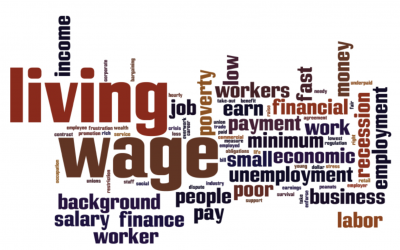As human beings we naturally seek to bring order to the chaos around us.
We evaluate our surroundings and interactions – consciously and unconsciously – and, over a period of time, we establish norms that define our expectations and behaviours.
Through such social evaluation we have determined that cultures – a melting pot of ideas, customs and behaviours – exist across society, including in our places of work.
Today, organisations widely recognise the value of engendering a deliberate and desired culture in the workplace.
Normally we seek to define and deliver this through a stated set of ‘values’. In doing so we are seeking to produce a framework to inform:
- The wanted behaviours and attitudes of our people
- The choices we make at every level of the organisation
- The company we keep
If those values and associated behaviours are ‘lived’ and they align to the purpose, objectives and strategy of an organisation, there are several examples where this has led to beneficial outcomes for all concerned – from supporting an enjoyable and inspiring workplace culture to delivering organisational success.
Patagonia, Ben & Jerry’s, adidas, Cox Automotive and Google have offered us some examples in recent years.
However, if those experiencing an organisation through its people or various ‘brand’ touchpoints do not encounter the anticipated behaviours – perhaps in their role as employees, customers or another form of stakeholder – at that point there is a disconnect between perception or promise and the reality of their experience.
This is the ‘values gap’.
When an organisation’s (normally self-identified) values are not being lived up to in practice, creating a values gap, it can cause a number of undesirable impacts.
Many organisations talk a good game when it comes to values – and contain many people with good intentions – but seem struggle to embed their officially desired behaviours internally to become the reality.
When reading a Forbes article entitled A superb strategy without the culture to support it leads to failure I was not surprised it cited a Gallup survey that found only 27% of employees strongly agree that they ‘believe in’ their company’s values and just 23% strongly agree they can apply their organisation’s publicly articulated values to their everyday work.
Does it matter?
From a business strategy perspective, if a set of behaviours are required to deliver against organisational objectives and this behaviour is not present, then clearly that is a direct route to failure. At this point the Peter Drucker saying ‘Culture eats strategy for breakfast’ comes into play.
From a reputational perspective, when expectations are not met it can cause damage to what internal and external audiences think about an organisation, and significantly hamper its licence to operate.
Haven’t we all experienced such a values gap?
A few years ago I remember walking into the reception atrium in Barclays’ UK HQ in London and remarking on the giant, free-standing and three-dimensional blocks of letters erected there that spelt out words including ‘integrity’ and ‘excellence’.
Apparently they were the company’s official values. I assumed they were there to leave no visitor in any doubt the bank stood for these things, but perhaps they were also an unmissable daily reminder to employees that living up to these values is what was expected of them.
I imagined their existence was the product of a collaboration of the bank’s communications and HR functions – as opposed to being truly embedded within the organisation at all levels – because shortly afterwards these giant words proved to be as lifeless as the material they were fashioned from.
Several bank employees were found guilty of manipulating the UK’s LIBOR rate and the EU’s Euribor rate, resulting in fines of $200 million by the Commodity Futures Trading Commission, $160 million by the US Department of Justice and £59.5 million by the Financial Services Authority. The scandal saw both the chairman and CEO of Barclays resign from their positions.
More recently, we have seen BrewDog, one of the UK’s fastest-growing brands, face a reputational issue due to criticism of its workplace culture by current and past employees. You could argue this has been exacerbated by the fact much of its reputation has been built on being purpose-driven and challenging the status quo. The brand leaned heavily on the very public actions of its founders, who perhaps lost some control of their organisational culture as the company grew.
This example leads into another: The Ellen DeGeneres Show. This award-winning and previously popular talk show is being wound-up at the end of this current season after claims of a toxic workplace culture heavily influenced by senior staffers drove a coach and horses through the image Ellen herself had traded off for some time.
What does this tell us?
I take a number of lessons from these examples and numerous others that I consider valuable and specifically about culture and values. In some cases perhaps they are worthy of further exploration:
- Firstly, it is so important to practice what we preach. The behaviour of an organisation’s people is so critical in producing an effective culture or conversely a values gap.
Even if a key part of embedding values is to build them in the first place ‘from the bottom up’ rather than have them ‘cast down’ by senior management, there is much evidence that leaders have a major impact on organisational culture.
Leaders must live up the organisation’s values when making strategic decisions, otherwise this is a quick route to them becoming meaningless. They are also influential in setting internal norms for what is acceptable, preferred or unwelcome behaviour.
- Looking at the examples I have cited, some might suggest a route to avoid a values gap is not to ‘fly too close to the sun in the first place’… ‘do not promise too much’… ‘just stay in your lane’…
This may be worthy of further exploration in terms of being careful not to overstate reality and set expectations too high from a reputational standpoint, but I cannot think of many examples where mediocrity is a path to success.
Moreover, increasing numbers of employees say they want to work for an organisation with defined core values and ones they identify with.
Therefore I suggest:
- It is vital to ensure your values are the right ones to help to achieve success by being authentic, ownable, deliverable and aligned to the organisation’s purpose and strategy.
- Then the values must be embedded throughout all levels of the organisation to ensure they are truly lived day-to-day.
- Once established, it is key to overtly recognise and reward good behaviour and tackle undesirable behaviour (and rogue actors full stop) as part of sustaining success and avoiding failure.
The huge words in Barclays’ reception seemed part of an intention to engender a positive, purpose-driven culture and yet the reality was different when performance results were on the line.
Were they the wrong values in the first place, were they poorly communicated, did employees not feel a true sense of ownership for them, did leadership fail to engender the right environment and do enough to eradicate rogue behaviour (or even encourage it if it resulted in quick financial wins) or something else?
- We must also recognise that most organisations cannot have a truly ‘singular’ culture when they are over a certain size or there are natural separations between people, such as being spread across different locations – or even floors or rooms of the same facility, let alone when you scale this globally and factor in all the existing cultural differences around the world being brought into the workplace.
If we appreciate the natural existence of a series of micro-cultures, which can bear almost no resemblance to one another within the same organisation, it strengthens the importance of applying a framework to provide some level of alignment in the form of a deliberate culture, values and behaviours programme within organisations. I believe it is healthy to embrace the differences as part of benefitting from diversity of thought and ideas, as opposed to groupthink.
- Finally, I also consider it important to recognise that some behaviours are conscious and deliberate, while others are unconscious and instinctive. The latter requires even more than good intentions and ‘buy-in’ to change.
For instance consistently rewarding the desired behaviour conditions us to recognise what we should be doing and how to act if we want to receive a positive response. Similarly pointing out unwanted behaviours is important to reduce or eradicate them, particularly when they are done unconsciously.
This list is by no means exhaustive and others will have acquired their own knowledge and experience to add to it.
To stand any chance of building and sustaining positive culture you must be ruthlessly deliberate and relentless in its pursuit, and that must be organisation-wide. It is certainly not a communications exercise.
If there is one thing I do know it is that we must be better than big words in a reception area if we want to mind the values gap.
Scott Bowers is Chief Corporate Affairs Officer at The Jockey Club



This is excellent. Most companies do talk a good game don’t they? How many live up to their values? i would start by leadership remembering what that company was invented to do in the first place!